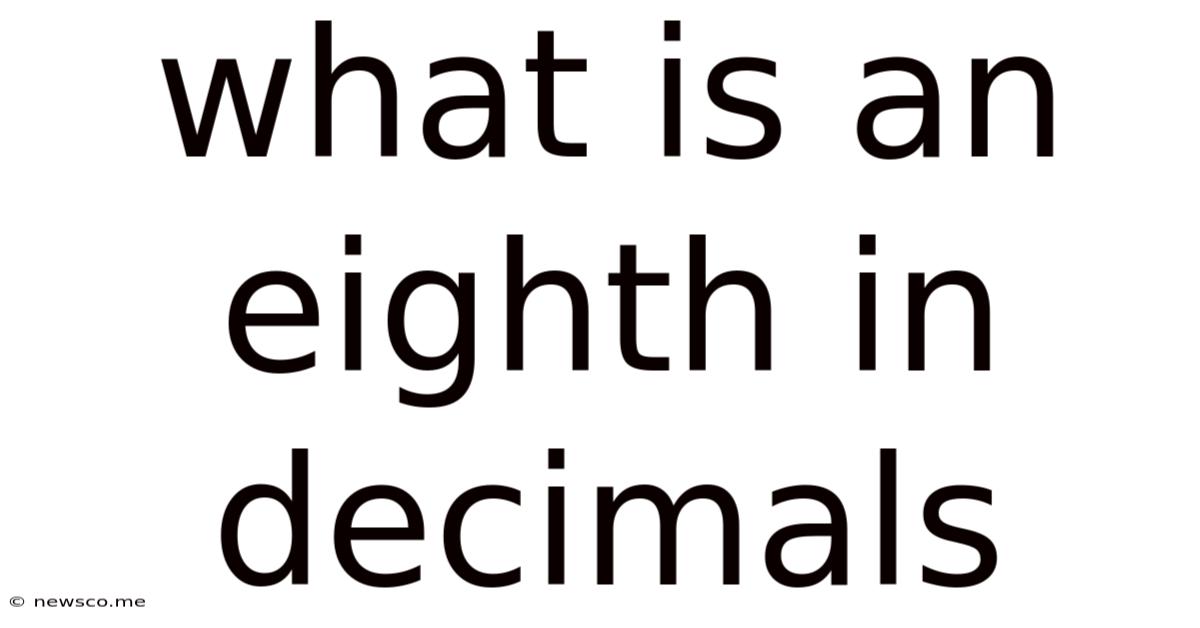What Is An Eighth In Decimals
News Co
Mar 22, 2025 · 4 min read

Table of Contents
What is an Eighth in Decimals? A Comprehensive Guide
Understanding fractions and their decimal equivalents is fundamental to mathematics and numerous real-world applications. This comprehensive guide will delve deep into the question: What is an eighth in decimals? We'll explore the conversion process, its practical uses, and related concepts to provide you with a thorough understanding.
Understanding Fractions and Decimals
Before we tackle the specific conversion of an eighth, let's refresh our understanding of fractions and decimals.
Fractions: Representing Parts of a Whole
A fraction represents a part of a whole. It consists of two numbers: the numerator (top number) and the denominator (bottom number). The numerator indicates the number of parts you have, and the denominator indicates the total number of equal parts the whole is divided into. For example, in the fraction 1/2 (one-half), the numerator is 1, and the denominator is 2, representing one part out of two equal parts.
Decimals: Another Way to Represent Parts of a Whole
Decimals are another way to represent parts of a whole. They use a base-ten system, where each place value to the right of the decimal point represents a power of ten (tenths, hundredths, thousandths, and so on). For example, 0.5 represents five-tenths, or 5/10.
Converting Fractions to Decimals
Converting a fraction to a decimal involves dividing the numerator by the denominator. This process works for all fractions, including those representing eighths.
What is an Eighth (1/8) in Decimals?
Let's focus on the specific question: What is one-eighth (1/8) in decimals? To find the decimal equivalent, we simply divide the numerator (1) by the denominator (8):
1 ÷ 8 = 0.125
Therefore, one-eighth (1/8) is equal to 0.125 in decimal form.
Understanding the Decimal Value of 1/8
The decimal 0.125 represents:
- 0: No whole numbers.
- 1: One-tenth.
- 2: Two-hundredths.
- 5: Five-thousandths.
This can also be expressed as:
0.1 + 0.02 + 0.005 = 0.125
Other Eighths in Decimal Form
Understanding the decimal equivalent of 1/8 allows you to easily calculate the decimal representation of other eighths:
- 2/8 (or 1/4): 2 ÷ 8 = 0.25
- 3/8: 3 ÷ 8 = 0.375
- 4/8 (or 1/2): 4 ÷ 8 = 0.5
- 5/8: 5 ÷ 8 = 0.625
- 6/8 (or 3/4): 6 ÷ 8 = 0.75
- 7/8: 7 ÷ 8 = 0.875
- 8/8 (or 1): 8 ÷ 8 = 1.0
Practical Applications of Knowing the Decimal Equivalent of 1/8
The knowledge of converting fractions to decimals, particularly the decimal equivalent of 1/8, has numerous practical applications across various fields:
1. Engineering and Design
Engineers and designers frequently work with precise measurements. Understanding fractions and their decimal equivalents is crucial for accurate calculations and blueprints. For instance, understanding 1/8th of an inch in decimal form (0.125 inches) is essential for precise machining or construction.
2. Cooking and Baking
Recipes often involve fractions, especially when dealing with smaller quantities of ingredients. Converting these fractions to decimals can help in more precise measurements, especially when using digital scales. Understanding 1/8 of a teaspoon or cup in decimal form aids in accurate baking and cooking.
3. Finance and Accounting
In finance and accounting, precise calculations are paramount. Converting fractions to decimals aids in calculations involving interest rates, discounts, and other financial computations. Understanding proportional shares represented as fractions and their decimal equivalents is crucial for accurate financial reporting.
4. Data Analysis and Statistics
In statistics, fractions and decimals are used to represent proportions and probabilities. Converting fractions to decimals simplifies calculations and data interpretation. Understanding percentages and proportions expressed as fractions and decimals is crucial for accurate data analysis.
5. Everyday Life
Many everyday situations involve fractions and decimals. Sharing items, measuring ingredients, or calculating discounts all require understanding and converting fractions to decimals for accurate calculations.
Advanced Concepts Related to Eighths and Decimals
1. Recurring Decimals
Not all fractions convert to exact decimal values. Some fractions result in recurring or repeating decimals, where a sequence of digits repeats infinitely. However, fractions involving powers of two in the denominator (like eighths) always result in terminating decimals.
2. Binary Representation
The decimal representation of 1/8 (0.125) is also closely related to the binary number system, which is fundamental to computing. Understanding this connection can deepen your understanding of the relationship between fractions and the digital world.
3. Significant Figures
When dealing with decimal values, it's important to understand significant figures. The number of significant figures indicates the precision of the measurement. This is crucial in scientific and engineering applications where accuracy is paramount.
Conclusion: Mastering Fractions and Decimals
This guide has explored the conversion of fractions, specifically focusing on what is an eighth in decimals. Understanding this conversion is a building block for more complex mathematical concepts. Mastering the relationship between fractions and decimals is invaluable in numerous fields, from engineering and finance to cooking and everyday life. By understanding these concepts, you equip yourself with essential skills for accurate calculations and problem-solving across various contexts. Remember, the ability to convert fractions to decimals and vice-versa is a fundamental skill that will enhance your mathematical abilities and problem-solving skills in various fields. Continual practice and applying these conversions in real-world scenarios will solidify your understanding and improve your fluency in working with fractions and decimals.
Latest Posts
Related Post
Thank you for visiting our website which covers about What Is An Eighth In Decimals . We hope the information provided has been useful to you. Feel free to contact us if you have any questions or need further assistance. See you next time and don't miss to bookmark.